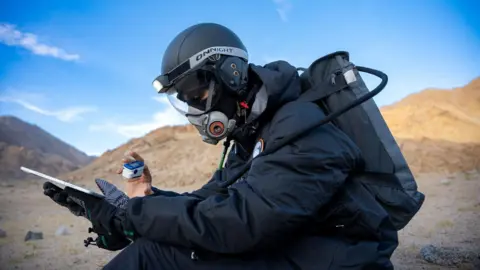Could our home look like this on the Moon or Mars?

 aka space studio
aka space studioWill this egg-shaped structure be the future home of Indian astronauts in space?
Habit-1 – short for Habitat-1 – is the Indian space agency ISRO’s first “analog mission” meant to simulate space conditions to prepare astronauts for real space missions. Recently it was tested for three weeks in the high Himalayan mountains of Ladakh.
Aastha Kacha-Jhala, a space architect at Gujarat-based firm Aaka, told the BBC that these simulations help identify and resolve problems faced by astronauts and equipment ahead of space missions.
Constructed with space-grade Teflon and insulated with industrial-use foam, the Hub-1 features a bed, a stowaway tray that can be taken out and used as a workstation, to hold supplies and an emergency kit. Storage space for food, a small kitchen for heating food and a toilet. In the simulation an astronaut spent three weeks hidden in the facility.
“Hab-1 is designed with the understanding that space on the Moon or Mars is going to be very limited,” says Ms Kacha-Jhala. “The astronauts will also have very limited water so we designed a dry toilet. We also created a system for proper disposal of waste and ensured that the habitat remained odor free.”
She is now in talks with ISRO to build India’s first permanent simulation space facility in Ladakh.
 aka space studio
aka space studioThis mission comes at a time when India is preparing to send its first astronauts into space.
ISRO’s Gaganyaan mission plans to place three astronauts in low-Earth orbit at an altitude of 400 km (248 mi) for three days. If everything goes according to plan, the mission will launch sometime next year. India also plans to set up its first space station by 2035 and send a man to the Moon by 2040.
NASA, the European Space Agency, Russia, China and other countries and private companies with space programs run dozens of simulation missions and two of the four Indian astronauts selected for the Gaganyaan mission are currently being trained at NASA.
“Once we have our own simulation missions, we will not have to depend on foreign space agencies to train our astronauts,” says Professor Subrata Sharma, dean of research studies at the University of Ladakh, who is collaborating on the project. “
He told the BBC that Ladakh was chosen for the experiment because “from a geological perspective, its rocky, barren landscape and soil have similarities with materials and rocks found on Mars and parts of the lunar terrain that make it suitable for space research.” Makes it ideal for.” ,
Soil samples collected during the mission are being tested by the university to see whether astronauts will be able to use locally obtained materials to build homes in space.
 aka space studio
aka space studioThe Himalayan region on the India–China border is located at an altitude of 3,500 meters (11,483 ft) and has extreme climatic conditions and thin air. The temperature here can go from maximum 20C to minimum -18C in a day.
It’s no match for Mars (where temperatures can drop as low as -153C) or the Moon (where -250C is standard in some deep craters), but still, it’s a test of human endurance. And as Professor Sharma says, “Since you cannot go to space every time to test, you need facilities where space-like conditions can be created”.
Plus, he says, Ladakh is a region of India where barren land stretches for miles, “giving you the feeling of being alone on the planet”.
And that’s exactly how it felt for the simulation astronaut who spent three weeks confined in a capsule in the icy cold desert.
“I was isolated from human surroundings. My every activity was scheduled, when to get up, what to do, when to sleep. A 24×7 camera monitored every activity and sent data about my activities and health to the back office ,” the 24-year-old man told me on condition of anonymity.
He said, “The first few days were great, but then it started feeling repetitive and it started taking over me. It started affecting my daily performance. My sleep schedule got affected a bit and my concentration deteriorated.”
The simulation astronauts wore biometric devices to monitor their sleep patterns, heart rates and stress levels. His blood and saliva were tested daily to see how he was coping.
 getty images
getty imagesScientists say simulating psychological factors to see how they would affect humans in space is one of the most important parts of the mission.
As space agencies around the world aim to send astronauts to the Moon and establish permanent bases there in the coming years, simulation missions are expected to play an important role in research and training.
In April, a team of scientists and engineers began testing in Oregon in preparation for NASA robot dog – Lassie – Walking on the surface of the moon. In July, four volunteers emerged after spending a year in a specially built “analog” facility in Texas Simulate life on Mars,
And according to the Economist magazine, NASA hopes to 3D-print a base using only materials found on the moon’s surface, while China and Russia are collaborating on their own plans.
India does not want to be left behind. Professor Sharma says that once the data collected in Ladakh is analyzed, it will “help us develop medical technology to deal with the needs of our astronauts when they encounter any problems in space “.
He says, “We need to know how our bodies will function on the Moon where days and nights are much longer than on Earth. Or in space where there is not enough oxygen.”
Follow BBC News India Instagram, youtube, Twitter And Facebook,






